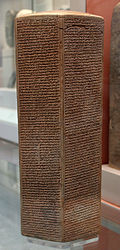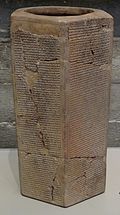Taylor prism

Final editions of Sennacherib's Annals – the Taylor Prism (above) and Jerusalem Prism (below)
|
|
 |
|
| Material | Clay |
|---|---|
| Size | Varies |
| Writing | Akkadian cuneiform |
| Created | c. 690 BCE |
| Discovered | From 1830 |
| Present location | Final editions in the British Museum,Oriental Institute of Chicago, and the Israel Museum |
Sennacherib's Annals are the annals of the Assyrian king Sennacherib. They are found inscribed on a number of artifacts, and the final versions were found in three clay prisms inscribed with the same text: the Taylor Prism is in the British Museum, the Oriental Institute Prism in the Oriental Institute of Chicago, and the Jerusalem Prism is in the Israel Museum in Jerusalem.
The Taylor Prism is one of the earliest cuneiform artifacts analysed in modern Assyriology, having been found a few years prior to the modern deciphering of cuneiform.
The annals themselves are notable for describing his siege of Jerusalem during the reign of king Hezekiah. This event is recorded in several books contained in the Bible including Isaiah chapters 33 and 36; 2 Kings 18:17; 2 Chronicles 32:9. The invasion is mentioned by Herodotus, who does not refer to Judea and says the invasion ended at Pelusium on the edge of the Nile delta.
The prisms contain six paragraphs of cuneiform written Akkadian. They are hexagonal in shape, made of red baked clay, and stand 38.0 cm high by 14.0 cm wide, and were created during the reign of Sennacherib in 689 BC (Chicago) or 691 BC (London, Jerusalem).
The Taylor prism is thought to have been found by Colonel Robert Taylor (1790–1852) in 1830 Nineveh, which was the ancient capital of the Assyrian Empire under Sennacherib, prior to its initial excavation by Botta and Layard more than a decade later. Although the prism remained in Iraq until 1846, in 1835 a paper squeeze was made by the 25-year-old Henry Rawlinson, and a plaster cast was taken by in c.1845. The original was later thought to have been lost, until it was purchased from Colonel Taylor's widow in 1855 by the British Museum. (Colonel Taylor may have been the father of John George Taylor, who, himself, became a noted Assyrian explorer and archaeologist.)
...
Wikipedia
